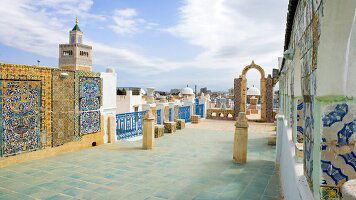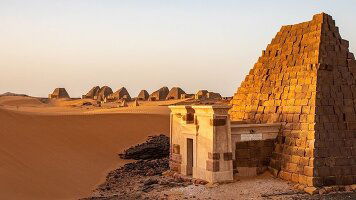Overview
Visit the lava lake at Erta Ale and witness the life of the salt mining Afar nomads that live in this otherwise inhospitable climate. In the north of Ethiopia, visit some of the most spectacularly located rock churches you’ll ever see. For classical history buffs, Axum is a gem. Relics from this ancient empire are still being discovered! read more Fly to the East to the ancient walled city of Harar, exploring the narrow alleyways where wild Hyenas still wander.
For the truly intrepid traveller, add on an extra 48 hours in Mogadishu with our experienced guide and security team.
Itinerary
Welcome to Ethiopia! Upon arrival in Addis, you will be met and transferred to your hotel. This afternoon, you will have a city tour which includes a trip to the Archaeological Museum (where you can meet 3.25-million-year-old Lucy), the Holy Trinity Cathedral, the Ethnological Museum (the former residence of His Majesty Emperor Haile Sellassie) and Mercato – the largest open-air market in Africa.
For those of you planning on collecting your Somaliland visa in Addis, this will be done so as priority. Stay: Nexus Hotel or similar
This morning, take a morning flight from Addis to Afdera (1.5 hrs.). From here, you will begin your journey by 4×4 where the Danakil Depression really begins. One of the lowest places in the world, it is an inhospitable landscape of sulphur springs, acid pools and colourful rock formations. Afdera is an isolated stratovolcano in northeastern Ethiopia, located at the intersection of three fault systems between the Erta Ale, Tat Ali, and Alayta mountain ranges. Stay: Afdera (B)
This morning you will visit the Afrera Salt Lake and witness the traditional salt excavation by the local people. Continue to Ert Ale base camp (Dodum) (50km, 2 hrs.).
Enjoy an early dinner before you start your trek to the rim of the volcano as you walk around pits and craters – here you will witness the spectacular drama of the active volcano of mount Ert Ale – this is the only permanent lava lake in the world, and nearby there is also another volcano bubbling lava. Stay: Camping (B/L/D)
Rise with the sun this morning as you visit Ert Ale a second time to experience the volcano's lake of lava in the daylight before continuing. Enjoy breakfast at Dodum base camp before driving to Hamedela (100 km, 4 hrs.), a far-flung settlement in a nomadic tribal area. Here you will have time to see how the nomadic people live in such inhospitable conditions. There will be time for photos and perhaps purchasing some items from the Afar people. Stay: Camping (B/L/D)
Today you will drive to Dallol (80 km, .2 hrs.). At 116 metres below sea level – this is the lowest place in the Danakil Depression and generally considered the hottest inhabited place on earth. You will spend half the day here crossing the largest depression, to see the black salt mountain (Lake Asaele), colourful sulphur and salt lakes as well as thermo-active springs. The route passes many camel caravans laden with salt crossing the bleak landscape. You'll also have time to meet some of the Afar people that live near Lake Assal. After lunch, drive to Mekele (120 km, 3 hrs.). Stay: Planet Hotel or similar (B/L/D)
Departing at 7am, drive to the rock-hewn churches of Tigray where you will visit some of the best rock-hewn churches in Ethiopia over the next two days named Abrha we Astsbawa, Abune-Yemata and Mariam Korkur churches.
Some of the 125 very aged Rock-Hewn churches even predate those at Lalibela and possibly represent a crucial link between Axum and Lalibela chronologically, artistically and technically. Until the mid-1960's, the churches were almost unknown outside Tigray itself. Even today very little is known about their magnificent and precarious positions which has led scholars to think they were being hidden from Muslims.
The landscape here is spectacular and those wanting to combine some trekking with terrific art and history, this is the perfect place, and we can tailor something for you this afternoon. Stay: Vision Motive Hotel (B/L/D)
After breakfast visit Mariam Korkur church which is cross-shaped and is famed for its rich decoration of columns, arches, and cupolas with fine frescoes. Continue to visit Abune Yemata and Dugum Selassie churches. Dugum Selassie possesses a beautifully carved ceiling above the maqdas (sanctuary), but it is tough to climb up to.
This afternoon, continue to Axum (120 km, 2.5 hrs.). Ethiopia is a place where history and myth blur together and nowhere is this more prevalent than in the capital of the great classical Axumite Empire. Believed to be founded by the Queen of Sheba and the final resting place of the Ark of the Covenant, Axum is a UNESCO world heritage site that is still being explored and excavated, each year throwing up new treasures. Stay: Sabian Hotel (B/L/D)
Enjoy a visit to the Axum Stelae Fields, where 120 stelae (giant granite pillars) are found, dating back to around 300-500 AD. Like the Pyramids in Egypt, they were built by ancient rulers to mark their achievement so they would be remembered after death. In the surrounding area you will visit Kaleb and Gabra's tombs and the Queen of Sheba's Palace and baths.
Whilst we will not be permitted to visit inside the Mary of Zion Church where the Ark of the Covenant is said to be, seeing the lines of white clothed pilgrims visiting is a moving sight. This afternoon, you will fly back to Addis (1.5 hrs). Stay: Nexus Hotel or similar (B)
This morning, take an early flight to Dire-Dawa (1 hr) where you will enjoy a city tour before driving to Harar (40km, 1 hr). Here you will explore the walled city with 368 alleys crammed into one square kilometre. Considered by some to be the 4th holiest city in Islam, the old city is famed for its medieval townhouses and has 82 mosques, including three built in the 10th century. The walls surrounding the sacred city of Harar were built between the 13th and 16th centuries. African and Islamic traditions combine, creating a particularly unique character. One of Harar's more unusual traditions is the nightly feeding of wild hyenas that wander the streets. Stay: Harar Ras Hotel or similar (B)
Today is a full day to drive from Harar to Hargeisa (150 km, 4 hrs.) crossing the border between Ethiopia and Somaliland on the way. As you progress you will pass out of the green Ethiopian lands into the brown scrub desert of Somalia, spotting camel trains as you drive. Stay: Hargeisa (B)
After a visit to the Hargeisa Camel Market, we will take you (with your security escort) to the wonderful cave paintings at Las Geel (70 km, 1.5 hrs. each way), one of the most intriguing sights in the Horn of Africa. On the overhangs of a rock in the desert are some of the world's best preserved ancient cave paintings. Dating from 5000-9000 years old they depict cows, people, dogs and even giraffes. Return to Hargeisa in the evening. Stay: Hargeisa (B)
This morning you will transfer to the airport for your morning flight to Addis. Upon arrival, connect to your onward international flight. (B)
Trip Inclusions
- Visit the Danakil Depression – one of the lowest and hottest places on earth
- Hike and camp on Erta Atale, an active volcano
- Visit the nomadic people of Hamed Ela nomadic living under inhospitable conditions
- Witness camel trains at the salt mines of Dallol
- Visit rock hewn churches including Tigray and Lalibela
- Explore the old walled city of Harar including seeing Harar's famed “hyena men” summon and feed wild hyenas
- Return airport transfers
- 11 nights accommodation
- Meals as per the itinerary
- Services of an English-speaking local guide
- Transportation in a private vehicle
- Domestic flights (Addis to Mekele / Axum to Addis Ababa / Addis Ababa to Dire Dawa)
- Camping equipment when in the Danakil Depression
- International flight from Hargeisa to Addis Ababa (or Hargeisa to Mogadishu if the guest is joining the Mogadishu add-on)
- International and domestic flights not mentioned above
- Visas
- Ethiopia visas ($ 50 USD each. You will need to get two if you return to Addis Ababa at the end of the trip)
- Somaliland Visa ($50USD in Addis Ababa)
- Hargeisa airport departure tax ($41USD)
- Travel and medical insurance
- All services, meals other than those indicated above
- Any changes to the proposed and confirmed program.
- All items of a personal nature e.g. drinks, laundry, telephone calls, tips etc
- Early check-in/Late check out
- Accommodation, itinerary and inclusions subject to change.
- Disruptions to itinerary may occur.
Dates & Pricing
 USD
USD
Your Global Journeys Travel Advisor will check the availability of your departure date when you Inquire. Additional savings may apply. T&C’s apply.
Tour & cruises prices are per person. Prices shown have savings applied, are subject to availability and may be withdrawn at any time without notice. Pricing and trip details are correct at this point in time, however are subject to confirmation at the time of booking and are subject to change by Crooked Compass. For cruise itineraries, cabin images are sourced from the cruise-line and should be treated as indicative only. Cabin inclusions, upholsteries and room layout may differ to the image(s) shown depending on the ship selected and your sailing dates.









